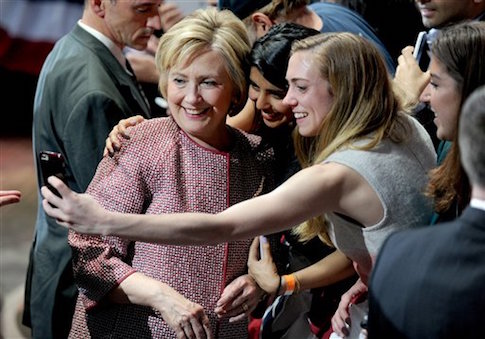"Washington, D.C., fundraiser" connotes, in my mind at least, a $1,000-plus per plate dinner with sea bass and wine by the case, heavily jowled guests, and a backslapping reception to follow.
The fundraiser I attended on Saturday night was different. Younger. Svelter. Just as bespectacled, but with more colorful acetate and fewer wire frames.
The organizers of the event—"Uncle Joe’s Malarkey Party for Hillz"—strove to put the fun in fundraiser. "Please Note," stated the event page. "This is a Joe Biden-themed party." The accompanying photograph captured the nation’s vice president double-fisting ice cream cones, one a swirl of chocolate and vanilla soft serve, the other a flavor of ice cream this writer can only speculate about. Butter pecan, perhaps? Peach?
![]() My ticket, the entry-level option most suited to a journalist’s salary, cost $20 and came with a complimentary friendship bracelet, an homage to the cutesy gift that Biden, age 73, supposedly crafted and gave to his coworker Barack for his birthday. I looked forward to getting a friendship bracelet, but felt a slight twinge of sadness as I purchased the ticket. Little more than a year had passed since I moved to the nation’s capital—full of ideals, determined to drain the swamp—and already I was a Hillary donor. This town does quick work on a guy.
My ticket, the entry-level option most suited to a journalist’s salary, cost $20 and came with a complimentary friendship bracelet, an homage to the cutesy gift that Biden, age 73, supposedly crafted and gave to his coworker Barack for his birthday. I looked forward to getting a friendship bracelet, but felt a slight twinge of sadness as I purchased the ticket. Little more than a year had passed since I moved to the nation’s capital—full of ideals, determined to drain the swamp—and already I was a Hillary donor. This town does quick work on a guy.
The fundraiser was held at Local 16, which despite its name is not a union hall full of 9/11 responder types but a restaurant in the U Street area with a rooftop bar and bottomless brunch special. My ticket was scanned by a cordial fellow who invited me to choose a friendship bracelet from a multi-colored tangle and directed my attention to a map of the world where attendees indicated with stickers where they would flee to if Trump were elected president. The biggest cluster of stickers was in Europe, with a few other predictable choices like New Zealand and Cuba. The wisest attendee had placed his or her sticker in the northernmost reaches of Siberia. I affixed my sticker in Moscow on the assumption that Trump would not nuke his closest strategic partner.
On the opposite side of the room was a large blank sheet of paper called the Malarkey Wall, where attendees were instructed to "tell us what really got your goat this year!" I was taken aback when I saw this. The event description had stated the contest would be about "what … really gets Joe’s goat," emphasis added, which meant I had come prepared with a set list about Amtrak funding, speechwriting deadlines, and ambush interviews. My best material was wasted.
Many of the answers written on the wall had to do with gender politics, as befitted a female-skewing event—things like "sexist standards," "glass ceiling," "smile," "I’M TOO SHRILL. #thatsnotathing," "dating in D.C.!," and "Keep your rosaries off my ovaries!" Some had to do with other facets of politics like "Brexit," "Everyone shut up about emails DAAAAAYUM!" and "American exceptionalism," punctuated by a frowny face.
The wall’s strident responses were not representative of conversations I had with attendees. The individuals I talked to at the party were well-educated, pleasant, socially conscious. Naturally they supported Clinton as a matter of cultural identity, but few expressed deep-rooted enthusiasm for her or for electoral politics generally, a finding at odds with the hyperbolic, YASSS QUEEN rhetoric of the event page. Many seemed to be attending because they were associates or friends of the organizers who, to judge from their social media presences, are Hillary enthusiasts of the first order. I spent more of my time talking about restaurants, bars, and up-and-coming areas of D.C. than about politics. With one group of women I discussed the fact that Jeremy Bentham’s stuffed corpse is kept in storage at University College London, which led to a conversation about how Bodies… The Exhibition, according to NPR, sources its cadavers from Chinese political prisoners.
Tucked away in the corner was the Selfie Station, which included an American flag backdrop with costume props like feather boas, giant sunglasses, and cutouts of Democratic notables such as Clinton, Biden, Kaine, and the Obamas. I watched party attendees gather round for a picture with Hillary’s face.
I couldn’t help but think that the scene was evidence of a generational shift in politics. To be sure, celebrity politicians like Kennedy, Reagan, and Obama have been around for a while. What seems to be new is the relentless celebritization—or perhaps more appropriately, the memeification—of politicians who do not obviously possess the charisma, charm, and good looks one assumes are required for celebrity status. It’s difficult to imagine the young people of the 1950s crowding in for pictures with a cutout of, say, John Foster Dulles. Yet Donald Trump’s young backers have attributed to their fat, plodding champion the attributes of a god; Hillary Clinton’s young supporters, for their part, have made her a pop star-like queen, transforming her as circumstances have demanded into a fun-loving, relatable rascal or a stone-cold, ceiling-busting shark. Only some of this image crafting has been done by the official campaign. The rest has been accomplished by unofficial Tumblrs, Twitter accounts, Malarkey Parties—the tools of the Meme Generation.
